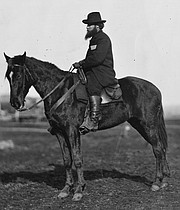Alfred Waud sketched the Mount Vernon mansion from a boat on the Potomac River. Likely on the same trip, he sketched Fort Washington, a bit up river and on the Maryland shore. Pencil on cream paper. Library of Congress
Mount Vernon — If indeed the pen is mightier than the sword, there was a time in American
warfare history when the pencil was just as robust. That was during the Civil War, when sketch artists traveled with military units on both sides to capture the deadly movement of men and horses that the rudimentary cameras of the era could not achieve. It was dangerous work, and one of these men, Theodore Davis, described the fundamental characteristic of a war artist: “Total disregard for personal safety.”
Englishman Alfred Waud (pronounced Wode) was the most prolific of what the New York newspapers called “special artists,” or “specials,” during the war. Soon after Confederate forces attacked Fort Sumter in South Carolina on April 12, 1861, three prominent illustrated weeklies in New York — Harper’s Weekly, Frank Leslie’s Illustrated Newspaper and the New York Illustrated News — sent specials to Washington D.C. Waud initially made field sketches for the Illustrated News, but shifted to Harper’s in early 1862. Throughout, he used pen, pencil and charcoal, plus a zinc-oxide pigment called “Chinese white” to add highlights.
Waud arrived in Washington in early May as Union military units began staging there in anticipation of Virginia joining other Southern states that had seceded. Virginians voted to join the Confederacy on May 23, and the following day, the Union Army seized control of Alexandria.
During June and the first two weeks of July, Waud moved about Washington, Alexandria and on the Potomac down to Mount Vernon, all the while sketching points of interest. One was obviously Washington’s estate, which was inside the area occupied by the Union Army. Groups of soldiers visited Mount Vernon, and generally followed orders from General Winfield Scott to “approach with due reverence, and leave undisturbed,” not only General Washington’s tomb, but also “the house, groves and walks which were so loved by the best and greatest of men.”
But in mid-July, Sarah Tracy, secretary to Ann Pamela Cunningham, the founder of the Mount Vernon Ladies Association, wrote to Vice Regent, Mrs. Joseph Comegys, about visiting soldiers. She described in her letter that a “large body of men came down and refused to stack their arms, but for over an hour straggling all over the place, without any order, their guns in their hands.” Waud must have been there at the time, for he sketched armed soldiers on the lawn below the mansion’s east side. Likely on the same excursion, he also drew a view of the home from the river that showed the mansion nestled among the adjacent trees.
Following a routine he used throughout the war, he sent the drawing to New York. There, Illustrated News artists turned Waud’s art into first a wood-block engraving and then, an electroplate used by the printing presses.
Waud covered the first Battle of Bull Run (or Manassas) on July 21, and, upon returning to Alexandria with the defeated and largely panicked Union forces, showed his mettle in a tight spot. When a Union soldier tried to steal his mount, according to Waud biographer, Frederic Ray, the plucky Waud drew his revolver and forced the man to retreat. In a story in the Illustrated News, Waud wrote of his next step, “I rode off devilish quick.”
Davis and Waud created drawings of the hostilities until the end of the war, the only two specials to do so without a respite. Many other specials joined the two men, some of whom later moved on to greater artistic endeavors – Winslow Homer and political cartoonist Thomas Nast, for example.
Waud continued to illustrate Harper publications until his 1891 death.

